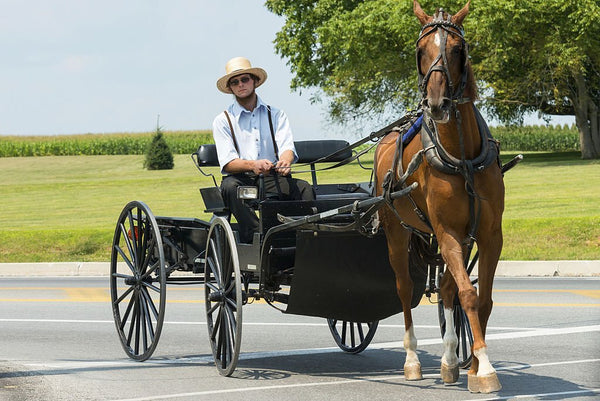The Church of the Brethren started in Germany in 1708. Alexander Mack formed it during the Radical Pietist Movement. The Amish, on the other hand, split from the Mennonites in Switzerland in 1693 to escape religious persecution.
Today, the Brethren and Amish are often lumped together due to similarities in their practices. Both groups are committed to pacifism, adult baptism (as opposed to infant baptism), and reject infant communion.
But when you look closer at Brethren vs Amish, the Amish have stricter dress, technology, and educational attainment rules. Brethren are more lenient regarding these things, with some orders allowing for more modern conveniences such as electricity, telephones, and computers. They also encourage higher levels of education.
What differentiates Brethren vs Amish? Let’s take a closer look.
What this article covers:
Who Are the Brethren?
The Brethren are a bigger and more progressive section of American anabaptists than the Amish. They account for 40% of American anabaptists, while old-order anabaptist Amish only account for 16%.

The Brethren practice pietist beliefs, pacifism, and Anabaptist non-conformity. This religious group stresses individual moral autonomy, but this hasn’t always been the case. Before the 1930s, they disciplined members for violating church teachings by denying them communion, disfellowshipping them, and in rare cases, shunning them.
Brethren put a lot of weight on loving relationships. After baptism, they hold the love feast, a significant ritual where members gather for a meal and share the bread and cup of communion.
That said, the Brethren have been through several struggles and have split into the following groups:
Church of the Brethren
This is the largest group with over 130,000 members. This church is similar to most mainstream denominations as it practices evangelical Christianity, emphasizing peace and social justice.
Old German Baptist Brethren
This group rejected evangelical practices and continues to practice traditional Anabaptist beliefs such as adult baptism and simple living.
Brethren in Christ
Originally called the River Brethren, they are perhaps the most unique section of the Brethren as they did not split from the Church of the Brethren. Instead, they were formed by eastern Pennsylvania Mennonites attracted by Brethren’s beliefs.
Dunkard Brethren
They felt that the Church of the Brethren was forgetting its apostolic ways and slipping into modern evangelicalism. They broke from the Church of the Brethren to practice a stricter version of Anabaptist beliefs and lifestyles.
The Old German Baptist Brethren, old order Brethren in Christ, and Dunkards are more similar to the Amish in practices such as living a simple life, dressing in plain clothing, and weaving quality hand-made picnic baskets that you can use for your outdoor events. Alternatively, you can check out hand-made Amish easter baskets for the upcoming holiday.
What’s the Difference Between the Amish and the Brethren?
Are Amish Catholic? No, they’re a different Christianity sect. Like the Brethren, the Amish churches have divided into different subgroups, the Old Order Amish being the most conservative group with stringent traditional beliefs and practices. Other Amish subgroups include:
- Swartzentruber
- New Order
- Beachy Amish
However, many differences between the Brethren and the Amish set them apart.
Beard Rules
Amish beard rules stipulate that a married man must keep a long beard without a mustache, as mustaches are considered worldly. The Brethren enforced similar rules in the 1880s, thought they weren’t strictly enforced.
Today, Brethren men wear different beard styles, some with mustaches, some without. Mostly these beard rules depend on the Brethren group. The Dunkards vs Amish, for instance, are similar as Dunkards must wear their beards in a plain and sanitary manner, without a mustache.

While Brethren vs Amish beard rules may vary, there’s a glaring difference between Amish and Mormon beard rules. Today, The Church of Jesus Christ of Latter-day Saints requires men to shave their beards. Men who work for the church cannot wear any beards or mustaches. However, congregants can sport nicely-trimmed beards.
Education
In Amish orders, members attend school until the eighth grade. Rarely will you find an Amish person attending college to pursue a higher level of education. However, some converts, such as Curtis Duff, who lives in Oakland, Maryland, has a medical background and is a rare example of an Amish person who obtained a college education.
Unlike Amish, Brethren encourage members to pursue higher education. The Church of the Brethren has founded several colleges, such as Bridgewater College in Virginia and Elizabethtown College in Pennsylvania, providing quality academic programs for those seeking a university experience.
Education is also different for Quakers and Amish. Quakers founded their first Friends school in 1689 but weren’t allowed to pursue higher education for a long time.
German Language
Amish communities speak Pennsylvania Dutch; their Bibles are written in New High German. Amish and Hutterites both use High German to worship. However, the Hutterites use Hutterisch for daily communication with each other.
On the other hand, Brethren are known to speak English in their worship and any other communication among themselves or outsiders. There is no German dialect that Brethren members learn and use for worship services or communal activities. Even Old Order German Baptist Brethren abandoned the use of German as a spoken language and now use English as their primary language in church.

Church Buildings
Unlike Puritans, Amish people have no church buildings but use their homes as churches. They practice “house meetings,” where members meet and worship in someone’s home each Sunday.
In contrast, the Church of the Brethren has buildings like other Christian denominations. The Brethren believe that having a physical space for worship brings them closer together and strengthens their faith. They worship in a Gospel Chapel, Christian Assembly, or Bible Chapel.
Conclusion
Brethren vs Amish beliefs are quite different. From beard rules to the level of education encouraged and church buildings, these religious groups have unique differences that make them stand out.
Some Brethren, such as the Plymouth Brethren, are also quite progressive and own computers in their homes. However, you’ll find some similar practices among these two groups, such as the holy kiss and the washing of feet. Both Amish and Brethren practice these two rituals to show their love for one another.
Did You Find Our Blog Helpful? Then Consider Checking:
- Shaker vs Amish
- Amish vs Mennonite Buggy?
- Amish Seventh-Day Adventists
- Mennonite vs Amish Clothing
- Why Did the Amish Split from the Mennonites?
- Types of Amish
- Amish Traditions
- Amish Dress Code
- Why Don’t Amish Use Buttons
- What Do the Amish Wear?
- Why Can’t Amish Women Have Buttons?
- What Are Amish People
- Amish Names
- Amish Female Names
- Amish Last Names

